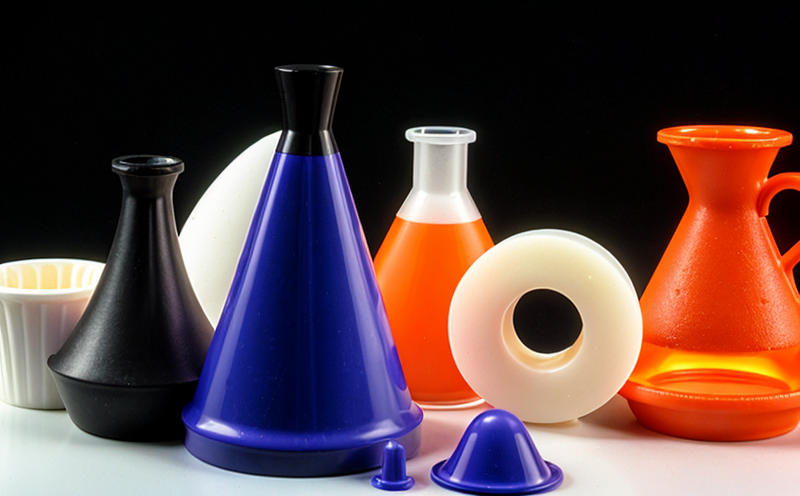ASTM D471 Rubber Additive Testing by Immersion
The ASTM D471 standard specifies a method for determining the resistance of rubber additives to oil and fuel through immersion testing. This service is particularly relevant for industries such as automotive, aerospace, and manufacturing where rubber components are exposed to various hydrocarbons during operation. Rubber additives play a critical role in enhancing the performance characteristics of polymers like nitrile butadiene rubber (NBR), neoprene, and ethylene propylene diene monomer (EPDM).
The ASTM D471 test is conducted by immersing rubber samples with additives into specified hydrocarbon media under controlled conditions. The primary objective is to assess the stability of the additives against degradation over time. This ensures that rubber components maintain their integrity and performance in real-world applications, which is crucial for maintaining safety standards and operational efficiency.
During this process, it's essential to follow strict protocols regarding specimen preparation. Specimens are cut into specific dimensions as per ASTM D471 requirements. The additives must be uniformly distributed within the rubber matrix prior to testing. This ensures accurate representation of the additive’s performance under immersion conditions.
The test apparatus used includes an oven for temperature control, a bath containing the specified hydrocarbon medium, and a weighing balance or digital scale for accurate measurement post-immersion. Acceptance criteria are defined based on weight loss, color change, or other visible signs indicative of degradation. Compliance with these criteria ensures that rubber components meet regulatory standards and customer specifications.
Testing samples under different conditions helps in identifying the most suitable additives for various environments. This information is invaluable for R&D departments looking to innovate and improve product offerings. For quality managers and compliance officers, this test provides a reliable method to ensure consistency across batches and adherence to industry best practices.
The ASTM D471 standard not only covers basic immersion tests but also includes more complex variations such as cyclic immersion and thermal aging. These additional methods provide deeper insights into the long-term performance of rubber additives in harsh environments. The data generated from these tests can significantly influence procurement decisions by helping to select high-quality suppliers who consistently deliver materials that meet stringent quality benchmarks.
Real-world applications of ASTM D471 testing include automotive fuel hoses, oil-resistant seals, and gaskets used in industrial machinery. By ensuring the stability of rubber additives through rigorous testing, we contribute to safer, more durable products that can withstand challenging operational conditions.
Industry Applications
| Application Area | Description |
|---|---|
| Automotive | Testing rubber components for fuel and oil resistance to ensure durability under operating conditions. |
| Aerospace | Evaluating seals and hoses for use in high-pressure hydraulic systems exposed to aviation fuels. |
| Manufacturing | Determining the longevity of rubber components used in manufacturing processes involving hydrocarbon exposure. |
| Oil & Gas | Assessing the performance of seals and gaskets used in oil wells where resistance to various oils is critical. |
| Test Parameters | Description |
|---|---|
| Hydrocarbon Medium | Specific hydrocarbons like naphtha, kerosene, or diesel are used to mimic real-world exposure scenarios. |
| Temperature Control | The immersion bath is maintained at a controlled temperature to simulate the operating conditions of the rubber components. |
| Time Duration | The duration for which specimens are immersed varies depending on the specific application and requirements. |
| Weighing Before & After Immersion | Differences in weight indicate the extent of degradation due to the hydrocarbon medium. |
Why Choose This Test
Ensures compliance with industry standards and regulations.
Provides reliable data for selecting high-quality rubber additives.
Helps in identifying the most suitable additives for specific applications.
Promotes consistent product quality across batches.
Supports R&D initiatives to innovate and improve product offerings.
Aids in making informed procurement decisions based on rigorous testing protocols.
Competitive Advantage and Market Impact
The ASTM D471 rubber additive test by immersion is instrumental in maintaining a competitive edge in the market. By ensuring that rubber components meet or exceed industry standards, this service enhances product reliability and safety. This translates into customer trust and satisfaction, which are key factors in building strong brand loyalty.
For quality managers and compliance officers, adherence to ASTM D471 not only simplifies regulatory compliance but also demonstrates a commitment to excellence. In the competitive landscape of manufacturing and supply chains, such reliability can be a differentiator. For R&D engineers, this test provides invaluable insights into material performance under real-world conditions, enabling them to innovate with confidence.
The data generated from ASTM D471 testing is crucial for procurement teams as it allows them to select suppliers who consistently deliver materials that meet stringent quality benchmarks. This proactive approach helps in reducing the risk of product failures and associated costs, thereby contributing to overall profitability and market leadership.
In conclusion, ASTM D471 rubber additive testing by immersion is a cornerstone service for maintaining high standards in polymer and additive analysis. Its impact extends beyond individual products, influencing industry trends and setting benchmarks for quality and performance across sectors.





